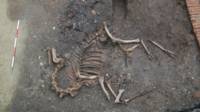- April 2, 2015
Post

Austrian archaeologists have discovered the skeleton of a camel battle, buried in the basement in a nearby city of Vienna, Tulln an der Donau in the XVII century.
The specific strain of bones indicate that the animal was of the harness and used for travel riding.
DNA analysis showed that it is a hybrid and single-humped Bactrian camel, which was launched specifically for the needs of the army – supposedly in the Ottoman Empire – since this species is larger and more resilient than its parents.
The Turks were pelleted Vienna in 1683, after which the camel battle seems to have been abandoned during the retreat or sold to local residents.
This is the first discovered by a skeleton of a camel in Central Europe. Scientists have already dubbed it “arhezoologicheskim treasure”.
A born warrior
Well-preserved skeleton was found during excavations in the construction of a new shopping center – in the midst of household waste , plates and saucepans, abandoned in the basement of a medieval house.
The archaeologist Alfred Gulick said that he and his colleagues did not immediately able to guess what kind of animal, and to recognize the uniqueness of their findings.

“At first I saw the lower jaw, – he says – that was similar to the jaw in cattle. But then I saw the cervical vertebrae and decided that it was a horse. And only the bones of the extremities helped to understand that this is the skeleton of a camel “.
According to his hypothesis, crowns retained camel as a curiosity, and perhaps exhibited his show, which explains why this hybrid dromedary and Bactrian (scientific names and single-humped Bactrian camels) did not get to anyone of the citizens on the table, and lived to old age and died a natural death.
“These hybrids were very uncommon for that time – says Gulick. – Their conclusion specifically for combat use,” – says Gulick.
Based on the deformation of the bones, it can be concluded that the camel is regularly used for riding, but there is no evidence of its use as a beast of burden.
According to the remains, the owner camel was very proud of his fighting friend and well cared about him.
No comments:
Post a Comment